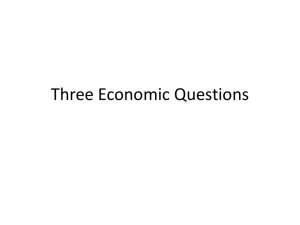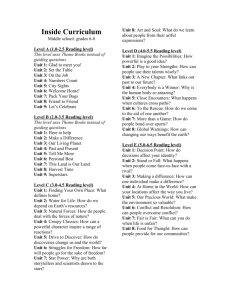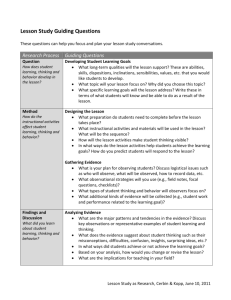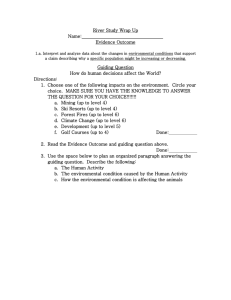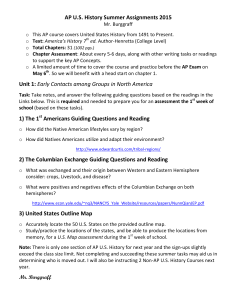Bow Valley Goals
advertisement
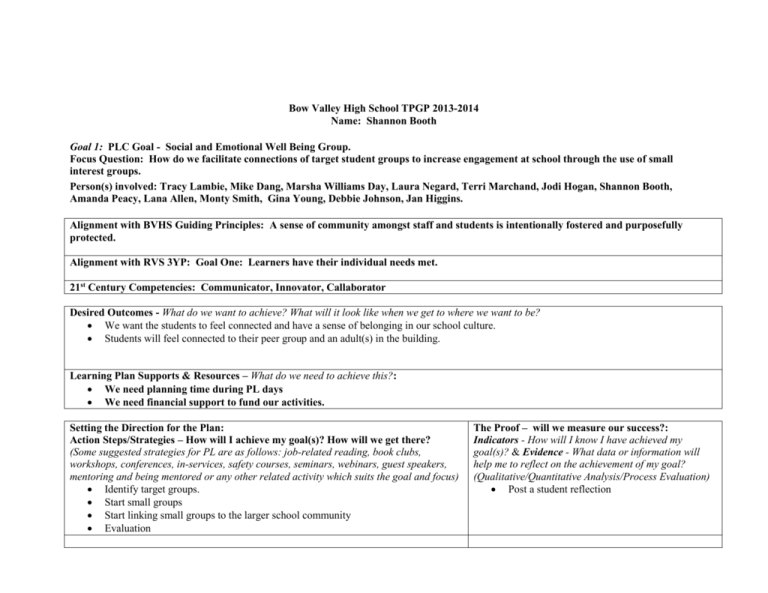
Bow Valley High School TPGP 2013-2014 Name: Shannon Booth Goal 1: PLC Goal - Social and Emotional Well Being Group. Focus Question: How do we facilitate connections of target student groups to increase engagement at school through the use of small interest groups. Person(s) involved: Tracy Lambie, Mike Dang, Marsha Williams Day, Laura Negard, Terri Marchand, Jodi Hogan, Shannon Booth, Amanda Peacy, Lana Allen, Monty Smith, Gina Young, Debbie Johnson, Jan Higgins. Alignment with BVHS Guiding Principles: A sense of community amongst staff and students is intentionally fostered and purposefully protected. Alignment with RVS 3YP: Goal One: Learners have their individual needs met. 21st Century Competencies: Communicator, Innovator, Callaborator Desired Outcomes - What do we want to achieve? What will it look like when we get to where we want to be? We want the students to feel connected and have a sense of belonging in our school culture. Students will feel connected to their peer group and an adult(s) in the building. Learning Plan Supports & Resources – What do we need to achieve this?: We need planning time during PL days We need financial support to fund our activities. Setting the Direction for the Plan: Action Steps/Strategies – How will I achieve my goal(s)? How will we get there? (Some suggested strategies for PL are as follows: job-related reading, book clubs, workshops, conferences, in-services, safety courses, seminars, webinars, guest speakers, mentoring and being mentored or any other related activity which suits the goal and focus) Identify target groups. Start small groups Start linking small groups to the larger school community Evaluation The Proof – will we measure our success?: Indicators - How will I know I have achieved my goal(s)? & Evidence - What data or information will help me to reflect on the achievement of my goal? (Qualitative/Quantitative Analysis/Process Evaluation) Post a student reflection Actualizing the Plan (the living part of the document): What WE DO over the course of the year to make plan viable Date 09/2013 Reflection & Analysis – How is this impacting student wellness? How is this impacting student achievement? What changes have been noted? Is the goal being achieved? What have we learned? What revisions and adjustments do we need to make? Other questions regarding the strategies and the proof indicators and evidence information above. Please provide any Qualitative and Quantitative data information where possible. Goal 2: Professional Goal (e.g. department, CofP, curricular, etc.): Create a method for students to explore the elective components of the choral music curriculum by exploring their personal interests and utilizing their creative skills to present the final product. Person(s) involved: BVHS Choir, Miss Booth Alignment with BVHS Guiding Principles: -Student directed learning will create increased engagement and relevance to the learning process -Effective instruction employs as many strategies as possible to facilitate the individual learning styles of students; exploration of a broad and diverse range of educational activities. Guiding Assessment Principles: -Assessment practices are transparent and consistent -Assessment practices give students a variety of opportunities to learn and develop through ongoing feedback Alignment with RVS 3YP: This goal aligns well with RVS 3YP goal no 2: Learners are self-directed, innovative, ecologically intelligent and entrepreneurial. The flexibility for students to design their own elective topic speaks to Outcome 1: ensuring learners become self-directed and take personal ownership of their learning. As the elective will speak to their own interest, it is my goal that their level of engagement and independence will increase. 2.1 no. 2 Percentage of teachers, parents and students who feel students have strong sense of ownership for their learning 2.2 no 2 Percentage of staff and parents who agree that students are critical, creative and complex thinkers 21st Century Competencies: Engaged Thinker: Critical Thinking and Problem Solving -Students will develop a critical thinking question in order to guide the topic of their choice; this will direct their research. Engaged Thinker: Creativity and Innovation -In giving students the opportunity to develop their own topic as well as method of presenting their final product, the allowance for their personal creativity and self directed innovation is targeted. Entrepreneurial Spirit: Lifelong Learning, Self-Direction and Personal Management -The majority of the assignment will be designed by the student. They will need to set personal milestones and develop a number of steps that must be taken in order to complete the final product. -In exploring a topic of their choice, the spark for intrinsic motivation should be ignited in order to promote further life-long learning. Desired Outcomes - What do we want to achieve? What will it look like when we get to where we want to be? Increased intrinsic motivation and engagement of students in musical concepts When achieved, students will have developed a product that encompasses a guiding critical thinking question to present information on a topic of their choice Learning Plan Supports & Resources – What do we need to achieve this?: -Student feedback -Alberta Program of Studies -University Consultant/Cohorts -Exemplars for students -Guiding questions/structure for product -Rubric -Assignment assessment Setting the Direction for the Plan: Action Steps/Strategies – How will I achieve my goal(s)? How will we get there? (Some suggested strategies for PL are as follows: job-related reading, book clubs, workshops, conferences, in-services, safety courses, seminars, webinars, guest speakers, mentoring and being mentored or any other related activity which suits the goal and focus) Job-related reading: how to infuse this method of differentiated instruction into the music classroom. Being mentored: University Consultant, Teaching Mentor at BVHS Seminar: Run a seminar with my University cohorts regarding this method of differentiated instruction in the music classroom. The Proof – how will we measure our success?: Indicators - How will I know I have achieved my goal(s)? & Evidence - What data or information will help me to reflect on the achievement of my goal? (Qualitative/Quantitative Analysis/Process Evaluation) As the product of the goal is primarily seen through the work of the students, the majority of my goal’s assessment will be qualitative. Has student intrinsic motivation increased in the curriculum? Students will complete an assessment of the assignment with questions guiding it’s success. (What did you like? What didn’t you like? What was the most difficult step in the process? Etc.) Actualizing the Plan (the living part of the document): What WE DO over the course of the year to make plan viable Date 09/2013 Create/distribute assignment 09/2013 Formative assessment of critical question topic 10/2013 Second draft/revision of critical thinking question & rough product complete 11/2013 Product complete/student assessment of product Reflection & Analysis – How is this impacting student wellness? How is this impacting student achievement? What changes have been noted? Is the goal being achieved? What have we learned? What revisions and adjustments do we need to make? Other questions regarding the strategies and the proof indicators and evidence information above. Please provide any Qualitative and Quantitative data information where possible.
